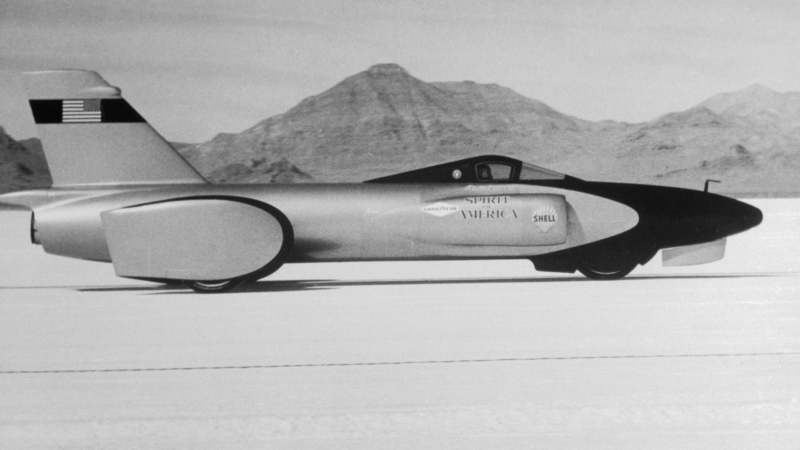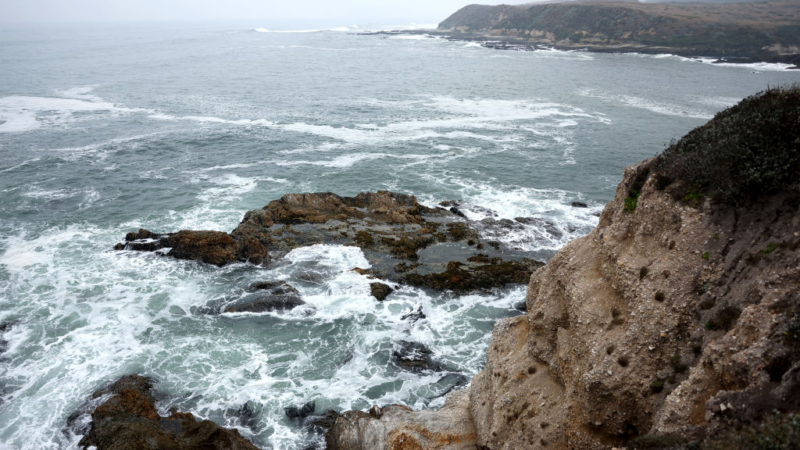60 years ago, a jet-powered tricycle shattered the land speed record
In a remote corner of northwestern Utah, there isn’t a rock, or tree, or even a blade of grass in sight — just miles and miles of salt in every direction. It’s here, at the Bonneville Salt Flats, where race car driver Craig Breedlove shattered the land speed record 60 years ago this week.
Breedlove had been going fast since he started drag racing as a teenager in Southern California, but President John F. Kennedy’s inaugural address — in which he invited Americans to “ask what you can do for your country” — inspired Breedlove to become the fastest. For decades, British drivers had claimed the land speed record, and Breedlove became determined to end their dominance.
He built a car that looked more like a rocketship, calling it the Spirit of America. Its sleek, silver-and-blue fuselage sat on three wheels and housed a jet engine salvaged from a fighter plane. A large American flag adorned its tail, and right below the cockpit was Breedlove’s name scrawled in stylish cursive.
Breedlove told NPR in 1996 that driving Spirit of America was “probably the greatest sensation of speed that anyone could ever experience.”
But even in the flat expanse of Bonneville, Breedlove faced obstacles. At the speeds he aimed to hit, enormous forces push the car upward and drag it downward. Breedlove had to be careful where he pointed the car, because it would go there — including straight up or straight down.
“It’s very much like driving on a sheet of ice,” Breedlove said. “It’s very, very slippery under the car. The tires tend to hydroplane on a film of air, and that happens at about 375 [mph] and up. And it’s noisy in the car, and the rough ride usually bounces you around a lot, and it’s real blurry to see because of the vibrations.”
With an average speed above 407 miles per hour, Breedlove reclaimed the top land speed for the U.S. in 1963, breaking a record that had stood for 16 years. His lasted for about a year until American half-brothers Walt and Art Arfons built their own competing jet cars and went even faster: 413 miles per hour, then 434 on Oct. 5, 1964.
Over the next two weeks, Breedlove returned to Bonneville with an upgraded Spirit of America and obliterated that mark.
On Oct. 15, dressed in a metallic blue race suit and a helmet emblazoned with stars, Breedlove adjusted his goggles as a mechanic fastened his oxygen mask. Then he scorched across the salt flats at 526 miles per hour — the fastest a human had ever gone on land, and the first to top 500 mph.

During its return run, the Spirit of America’s drag parachute malfunctioned. Breedlove skidded off course for 5 miles before hitting a telephone pole and crashing into a lake.
Thoroughly soaked but unhurt, he climbed out of the cockpit. He was beaming, seemingly giddy with adrenaline.
“What a ride,” Breedlove said. “And for my next trick, I’ll set myself on fire.”
Craig Breedlove’s record was broken by Art Arfons just two weeks later. He returned to Bonneville the next year to reclaim it — at more than 600 miles per hour.
The land speed record has been increased four times since, returning to British hands in 1983. The current record was set by the car ThrustSSC, driven by Britain’s Andy Green. In 1997 he hit 763 mph, becoming the first driver — and so far the only one — to break the speed of sound.
In an election race this close, Asian American voters have become a force
Asian Americans are the fastest growing-voting group in the country. That means parties are courting them in tight races in states like Pennsylvania.
Highlighting Indigenous voices across NPR’s network
NPR is celebrating Indigenous Peoples' Day by acknowledging Indigenous people's accomplishments and delving into their culture and the issues they face with stories from our network.
China holds large military exercises surrounding Taiwan to warn against independence
China deployed ships and warplanes in large-scale military exercises surrounding Taiwan Monday, simulating the sealing off of ports in a move that underscores the tense situation in the Taiwan Strait.
The U.S. gets a new national marine sanctuary, the first led by a tribe
Over 4,500 square miles of ocean will be protected off the California coast. It will also be managed in partnership with the indigenous groups that fought to create it.
Come hurricane or high water, Florida island residents promise to stay
As climate change makes hurricanes stronger and more intense, island communities like Longboat Key are particularly susceptible to catastrophic damage from hurricanes. Residents say they are sticking around.
To curb polio outbreak, children in Gaza are receiving a booster vaccine dose
The World Health Organization said a second dose will be crucial in order to stop the spread of the virus in Gaza and internationally.






